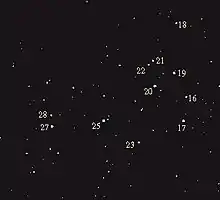| Observation data Epoch J2000 Equinox J2000 | |
|---|---|
| Constellation | Taurus |
| Right ascension | 03h 46m 02.90030s[1] |
| Declination | +24° 31′ 40.4313″[1] |
| Apparent magnitude (V) | 6.43[2] |
| Characteristics | |
| Spectral type | A0 Vn[3] |
| B−V color index | −0.020±0.006[2] |
| Astrometry | |
| Radial velocity (Rv) | +6.9±1.3[2] km/s |
| Proper motion (μ) | RA: +19.599[1] mas/yr Dec.: −45.077[1] mas/yr |
| Parallax (π) | 7.3453 ± 0.0921 mas[1] |
| Distance | 444 ± 6 ly (136 ± 2 pc) |
| Absolute magnitude (MV) | 1.00[2] |
| Details | |
| Radius | 3.1[4] R☉ |
| Luminosity | 63.6[2] L☉ |
| Surface gravity (log g) | 4.209±0.113[5] cgs |
| Temperature | 11,817±191[5] K |
| Metallicity [Fe/H] | −0.1[6] dex |
| Rotational velocity (v sin i) | 232[6] km/s |
| Other designations | |
| Database references | |
| SIMBAD | data |

22 Tauri is a component of the Asterope double star in the Pleiades open cluster. 22 Tauri is the stars' Flamsteed designation. It is situated near the ecliptic and thus is subject to lunar occultation.[9] The star has an apparent visual magnitude of 6.43,[2] which is near the lower threshold of visibility to the naked eye. Anybody attempting to view the object is likely to instead see the Asterope pair as a single elongated form of magnitude 5.6.[10] Based upon an annual parallax shift of 7.35 mas,[1] this star is located 444 light years away from the Sun. It is moving further from the Earth with a heliocentric radial velocity of +7 km/s.[2]
This is an ordinary A-type main-sequence star with a stellar classification of A0 Vn.[3] The 'n' suffix indicates the spectrum displays "nebulous" absorption lines due to rapid rotation. This is confirmed by a high projected rotational velocity of 232 km/s.[6] The star is radiating sixty times the Sun's luminosity from its photosphere at an effective temperature of 11,817 K.[5]
References
- 1 2 3 4 5 6 Brown, A. G. A.; et al. (Gaia collaboration) (August 2018). "Gaia Data Release 2: Summary of the contents and survey properties". Astronomy & Astrophysics. 616. A1. arXiv:1804.09365. Bibcode:2018A&A...616A...1G. doi:10.1051/0004-6361/201833051.
- 1 2 3 4 5 6 7 Anderson, E.; Francis, Ch. (2012), "XHIP: An extended hipparcos compilation", Astronomy Letters, 38 (5): 331, arXiv:1108.4971, Bibcode:2012AstL...38..331A, doi:10.1134/S1063773712050015, S2CID 119257644.
- 1 2 Cowley, A.; et al. (April 1969), "A study of the bright A stars. I. A catalogue of spectral classifications", Astronomical Journal, 74: 375–406, Bibcode:1969AJ.....74..375C, doi:10.1086/110819.
- ↑ Pasinetti Fracassini, L. E.; et al. (February 2001), "Catalogue of Apparent Diameters and Absolute Radii of Stars (CADARS)", Astronomy and Astrophysics (Third ed.), 367 (2): 521–524, arXiv:astro-ph/0012289, Bibcode:2001A&A...367..521P, doi:10.1051/0004-6361:20000451, S2CID 425754.
- 1 2 3 David, Trevor J.; Hillenbrand, Lynne A. (2015), "The Ages of Early-Type Stars: Strömgren Photometric Methods Calibrated, Validated, Tested, and Applied to Hosts and Prospective Hosts of Directly Imaged Exoplanets", The Astrophysical Journal, 804 (2): 146, arXiv:1501.03154, Bibcode:2015ApJ...804..146D, doi:10.1088/0004-637X/804/2/146, S2CID 33401607.
- 1 2 3 Gebran, M.; et al. (2016), "A new method for the inversion of atmospheric parameters of A/Am stars", Astronomy & Astrophysics, 589: A83, arXiv:1603.01146, Bibcode:2016A&A...589A..83G, doi:10.1051/0004-6361/201528052, S2CID 118549566.
- ↑ Allen, Richard Hinckley (1963), Star names - Their Lore and Meaning, Dover Books, p. 407, retrieved 2016-09-14.
- ↑ "22 Tau". SIMBAD. Centre de données astronomiques de Strasbourg. Retrieved November 21, 2018.
- ↑ Schmidtke, P. C.; Africano, J. L. (2011), "KPNO Lunar Occultation Summary. III", The Astronomical Journal, 141 (1): 10, Bibcode:2011AJ....141...10S, doi:10.1088/0004-6256/141/1/10.
- ↑ Schaaf, Fred; Myers, Doug (2012), Seeing the Sky: 100 Projects, Activities & Explorations in Astronomy, Dover Books on Astronomy, Courier Corporation, p. 56, ISBN 978-0486488882